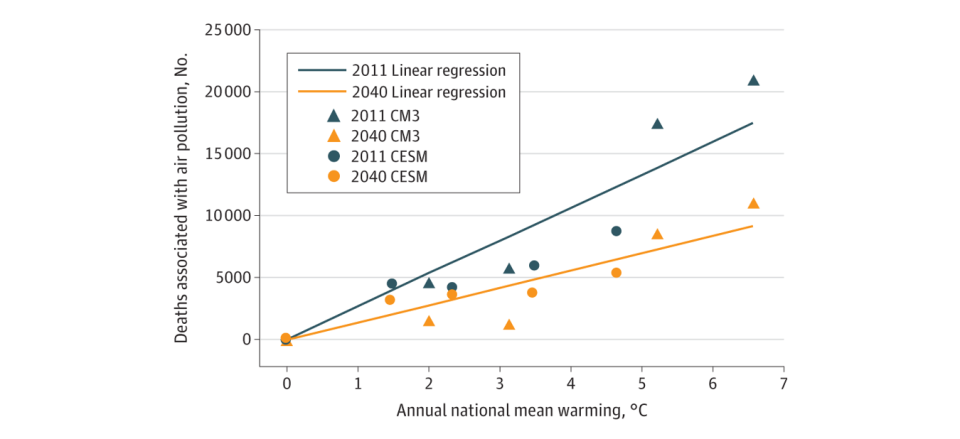Projecting Changes to Human Health with CMAQ
As of 2023, approximately 140 million Americans lived in counties where air pollution levels exceeded one or more of the National Ambient Air Quality Standards. Ground-level ozone and fine particle pollution (PM2.5) are the overwhelming contributors to these cases of poor air quality, and both of these pollutants have significant adverse effects on human health through respiratory and/or cardiovascular impacts. Actions to reduce the emissions that lead to high levels of ozone or fine particles have been extremely successful over the past few decades. Since 2000, ozone levels have been reduced by 17% and fine particle concentrations have been reduced by 37% (USEPA, 2024).
However, climate change has the potential to slow the improvements to U.S. air quality by altering weather patterns and increasing the prevalence of conditions that lead to episodes of poor air quality (Jacob and Winner, 2009; Fiore et al., 2015). CMAQ analyses of the effects of climate change on air quality have informed the U.S. Global Change Research Program Climate and Health Assessment (Fann et al., 2016; USGCRP, 2016) as well as the Fourth National Climate Assessment (Nolte et al., 2018a; USGCRP, 2018).

Future projections from global climate models were dynamically downscaled using the Weather Research and Forecasting (WRF) model to generate the evolution of weather conditions over North America during the 21st century. These WRF fields were then used with CMAQ to simulate air quality under different emissions scenarios (Nolte et al., 2021). The outcomes from the WRF and CMAQ projections were used to quantify potential health effects resulting from changes to climate and air quality. The future health impacts of climate change resulting from degraded air quality could be significant, leading to an estimated 25000 additional deaths by 2095. However, reducing future air pollutant emissions has the potential to reduce the climate-driven increase in deaths by hundreds to thousands (Fann et al., 2021).

References
Fann, N., Brennan, T., Dolwick, P., Gamble, J.L., Ilacqua, V., Kolb, L., Nolte, C.G., Spero, T.L., Ziska, L. (2016). Ch. 3: Air Quality Impacts. In The Impacts of Climate Change on Human Health in the United States: A Scientific Assessment. U.S. Global Change Research Program, Washington, DC, 69–98.
Fann, N., Nolte, C.G., Dolwick, P., Spero, T.L., Curry Brown, A., Phillips, S., Anenberg, A. (2015). The geographic distribution and economic value of climate change-related ozone health impacts in the United States in 2030. J. Air Waste Manage. Assoc., 65, 570–580, doi:10.1080/10962247.2014.996270.
Fiore, A.M., Naik, V., Leibensperger, E.M. (2015). Air quality and climate connections. J. Air Waste Manage. Assoc., 65, 645-685, doi:10.1080/10962247.2015.1040526.
Jacob, D.J., Winner, D.A. (2009). Effect of climate change on air quality. Atmos. Environ., 43, 51-63, doi:10.1016/j.atmosenv.2008.09.051.
Nolte, C.G., Dolwick, P.D., Fann, N., Horowitz, L.W., Naik, V., Pinder, R.W., Spero, T.L., Winner, D.A., Ziska, L.H. (2018a). Air Quality. In Impacts, Risks, and Adaptation in the United States: Fourth National Climate Assessment, Volume II, U.S. Global Change Research Program, Washington, DC.
Nolte, C.G., Spero, T.L., Bowden, J.H., Mallard, M.S., Dolwick, P. (2018b). The potential effects of climate change on air quality across the conterminous U.S. at 2030 under three Representative Concentration Pathways. Atmos. Chem. Phys., 18, 15471-15489, doi:10.5194/acp-18-15471-2018.
USEPA, 2024: Our Nation's Air: Trends Through 2023. https://gispub.epa.gov/air/trendsreport/2024/
USGCRP, 2016: The Impacts of Climate Change on Human Health in the United States: A Scientific Assessment. Crimmins, A., J. Balbus, J.L. Gamble, C.B. Beard, J.E. Bell, D. Dodgen, R.J. Eisen, N. Fann, M.D. Hawkins, S.C. Herring, L. Jantarasami, D.M. Mills, S. Saha, M.C. Sarofim, J. Trtanj, and L. Ziska (eds.). U.S. Global Change Research Program, Washington, DC, 312 pp.
USGCRP, 2018: Impacts, Risks, and Adaptation in the United States: Fourth National Climate Assessment, Volume II. Reidmiller, D.R., C.W. Avery, D.R. Easterling, K.E. Kunkel, K.L.M. Lewis, T.K. Maycock, and B.C. Stewart (eds.). U.S. Global Change Research Program, Washington, DC, 1515 pp.
